by Megan Ogilvie & Joseph Hall
The microchip technology, created by a pair of University of Toronto scientists, will be able to determine the severity of the tumours through a simple urine sample and produce quick diagnosis with no need for painful biopsies.
Now heading into the engineering stage, a BlackBerry-sized device should be available for doctors’ use within two to three years and eventually could be tuned to detect a broad range of cancers and infectious ailments, the researchers say.
“The goal would be to produce a result … while you’re sitting in the waiting room,” said engineering professor Ted Sargent, who holds the U of T’s Canada Research Chair in Nanotechnology.
A paper on the work was published yesterday in the journal Nature Nanotechnology.
The device uses a fingertip-sized microchip – fitted with microscopic meshing – programmed to detect DNA sequences and proteins uniquely produced by specific cancers or pathogens.
These “biomarkers” would be drawn from urine or blood samples.
“We simply put a sample on the chip and we have a nice small chip reader that then analyses it and tells you what markers are in the sample,” said Shana Kelley, a U of T pharmacology professor and study co-author.
Detected markers can tell you not only which kind of cancer is present, but also the stage and severity the tumour has attained.
“That’s very important to be able to do that because cancers are actually a bunch of different diseases with different levels of aggressiveness,” said Kelley. “Particularly in prostate cancer, there are very non-aggressive forms … that you simply want to leave alone.”
Kelley said the technology could herald an age of surgery-free diagnosis for cancer patients. “The real drive is toward non-invasive diagnostics so we can just screen people without having to take parts of their organs in order to do it,” she said.
Dr. Tom Hudson, scientific director of the Ontario Institute for Cancer Research, said the study is “proof of principle” that it is possible to have a quick, affordable technology that can test for different cancer biomarkers at once.
“This is a critical step,” he said. “They have shown you can detect this gene mutation (for prostate cancer). And if you extrapolate that you can do it for one gene, you could probably do it for 100 or 1,000.”
Scientists are working hard to identify biomarkers for specific cancers and test those markers’ usefulness in diagnosing cancer in patients. Some 1,000 biomarkers have been found, but Hudson said only nine of those have been validated so far in the clinic.
The other challenge is to find a way to test for many different biomarkers at once and develop a cost-effective technology to do it.
Hudson cautioned the device is still a long way off from being a staple in doctor’s offices.
“How we make these (biomarker) tests happen in the clinic or in the clinical lab really needed some advances in technology. And Kelley and Sargent have done all the proof of principles here for a technology that’s going to work.”
For the initial work, Sargent and Kelley looked at prostate cancer, which has a set of signature biomarkers, shown in many studies to accurately portray the presence and severity of that disease.
The pair showed the chips were well able to pick up these makers in the minuscule concentrations typically found in the urine of prostate cancer patients.
But even now, Kelley said, they are shifting the technology’s sights to other cancers and ailments.
“We’ve already done a little bit of work with head and neck cancer,” Kelley said. “But really any cancer where there is an established molecular profile, we should be able to pick up using this device.”
Sargent said he envisions the devices being a commonplace tool in doctors’ offices around the world, along with a binder full of chips for different cancers and diseases.
“Say you were looking for H1N1 (influenza) or some dangerous infectious agent, there could be chips specific to those,” he said. “You would just insert the proper one.

